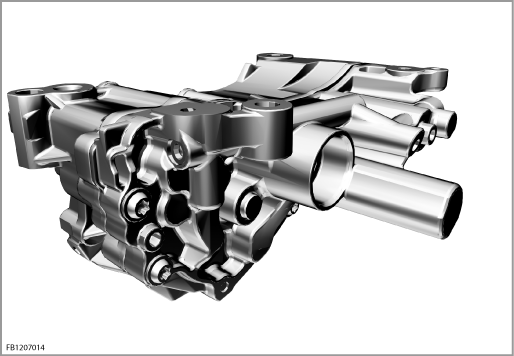
The oil pump must ensure a reliable oil supply under all operating conditions. The new engines have characteristic-map-regulated activation of the oil pump (not volume-flow-regulated). This pump only supplies the amount of oil required by each operating range of the engine. The following advantages result:
The oil-pressure control is electrically activated by the DME via an electrohydraulic oil pressure regulating valve (solenoid valve). The oil pressure sensor handles the monitoring.
The electrical activation enables further optimisation of the power dissipation of the oil pump.

The following components are described:
A familiar pendulum slide cell pump is used as the oil pump. The pump shaft for the supply is seated off-centre in the housing and the vanes are displaced radially during rotation. This means that the vane chambers form different volumes. When the volume rises, the oil is taken in; when the volume decreases, oil is pressed into the oil ducts.
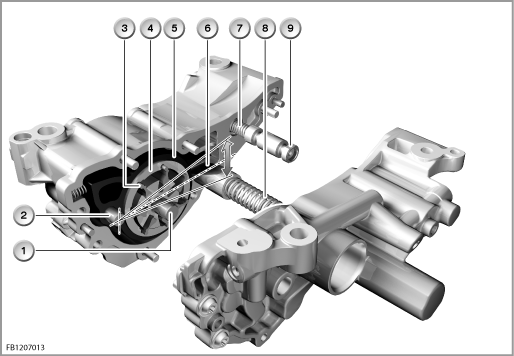
Index |
Explanation |
Index |
Explanation |
|---|---|---|---|
1 |
Pump shaft |
2 |
Rotational axis |
3 |
Vane |
4 |
Rotor |
5 |
Pendulum slide |
6 |
Control piston, pendulum support |
7 |
Control spring |
8 |
Compression spring |
9 |
Control piston |
|
|
The oil pump is driven by a chain from the crankshaft.
The oil pressure regulating valve is a solenoid valve (3/2-way valve). The solenoid valve is seated in the crankcase at the side. The Digital Engine Electronics (DME) activate the oil pressure regulating valve by means of a pulse-modulated signal.
This enable more precise activation of the oil pump than via the volumetric flow.
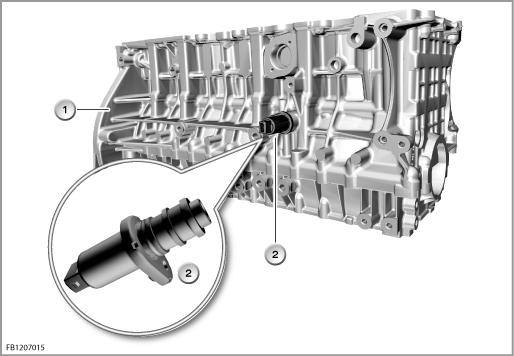
Index |
Explanation |
Index |
Explanation |
|---|---|---|---|
1 |
Crankcase |
2 |
Oil pressure regulating valve |
The oil pressure sensor is bolted directly onto the oil filter. The oil pressure sensor measures the pressure generated by the oil pump. The oil pressure is measured relative to the ambient pressure.
The signal is sent to the DME control unit.
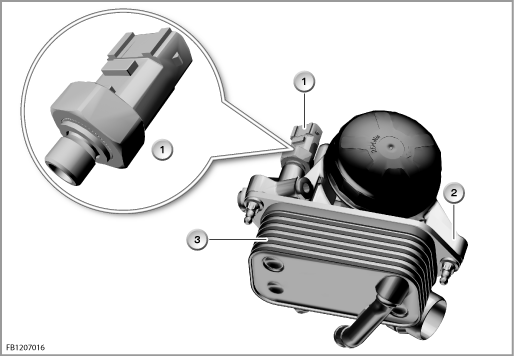
Index |
Explanation |
Index |
Explanation |
|---|---|---|---|
1 |
Oil pressure sensor |
2 |
Oil filter |
3 |
Oil-water heat exchanger |
|
|
The following system functions are described:
The oil pressure also controls the supplied oil volume in line with requirements.
However, the DME controls the characteristic-map-regulated oil-pressure control. To this end, the following input variables are used:
The following overview shows a diagram of the regulating circuit:
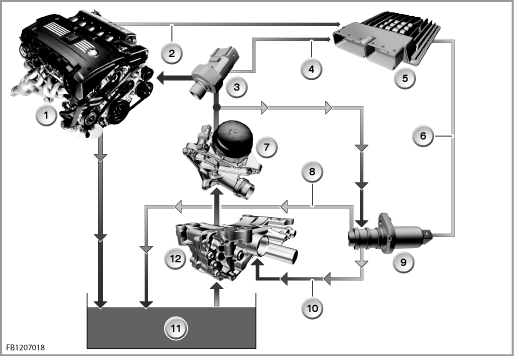
Index |
Explanation |
Index |
Explanation |
|---|---|---|---|
1 |
Engine (e.g. N53) |
2 |
Signals from the sensors on the engine |
3 |
Oil pressure sensor |
4 |
Signal from oil pressure sensor |
5 |
DME control unit |
6 |
Activation of the oil pressure regulating valve (3/2-way valve) |
7 |
Oil filter |
8 |
Venting of the oil pressure regulating valve |
9 |
Oil pressure regulating valve |
10 |
Control line for oil pressure regulating valve |
11 |
Oil sump |
12 |
Oil pump |
The DME activates the oil pressure regulating valve with a pulse-width modulated signal. The oil pressure regulating valve then sets the corresponding oil pressure that is applied to the control piston of the oil pump.
The characteristic-map-regulated oil pump enables even more precise control of the oil pump. This means that the measure makes an additional contribution to reducing fuel consumption and lowering the level of CO2.
The required oil pressure is lowered via the engine speed range. Compared to volume-flow control, the oil pump has to generate less pump output.
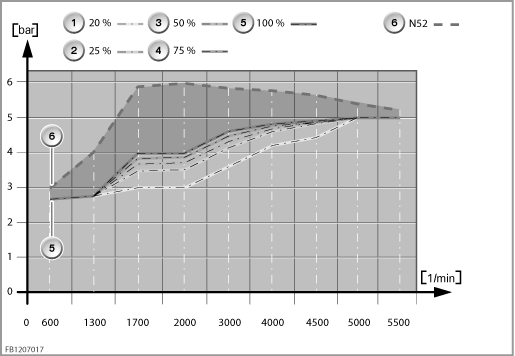
The diagram shows load-dependent oil pressure at an engine oil temperature of 100 °C
Index |
Explanation |
Index |
Explanation |
|---|---|---|---|
1 |
Curve 20 % |
2 |
Curve 25 % |
3 |
Curve 50 % |
4 |
Curve 75 % |
5 |
Curve 100 % (full load) |
6 |
Curve for volume-flow control, e.g. N52 |
Note: failure of the oil-pressure control.
If the characteristic-map-regulated oil-pressure control fails, the oil supply is volume-flow-regulated (emergency operation). Depending on the engine version, an increase in fuel consumption of up to 5 % is the consequence.
No liability can be accepted for printing or other errors. Subject to changes of a technical nature